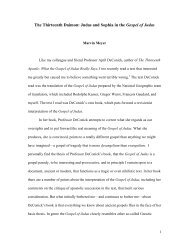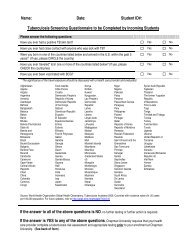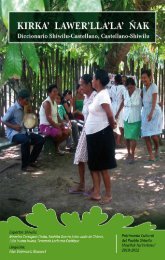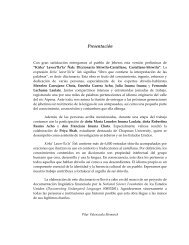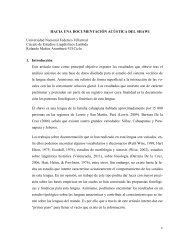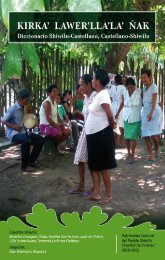“Surplus Humanity” and the Margins of Legality - Chapman University
“Surplus Humanity” and the Margins of Legality - Chapman University
“Surplus Humanity” and the Margins of Legality - Chapman University
Create successful ePaper yourself
Turn your PDF publications into a flip-book with our unique Google optimized e-Paper software.
Do Not Delete 12/12/2010 7:34 PM<br />
30 <strong>Chapman</strong> Law Review [Vol. 14:1<br />
reconfigured selected urban areas to serve <strong>the</strong>se ends. 191 A<br />
defining feature <strong>of</strong> <strong>the</strong> designed colonial cities was <strong>the</strong> spatial<br />
divide between <strong>the</strong> centers <strong>of</strong> gravity <strong>of</strong> colonial presence <strong>and</strong> <strong>the</strong><br />
native quarters. Zoning <strong>and</strong> institutionalized governance whose<br />
jurisdiction is coextensive with <strong>the</strong> territory <strong>of</strong> <strong>the</strong> city, <strong>the</strong><br />
hallmarks <strong>of</strong> a modern city, were but rarely extended to <strong>the</strong><br />
native quarters. 192 Natives not recruited into colonial security,<br />
administrative, <strong>and</strong> commercial regimes, remained at or beyond<br />
<strong>the</strong> spatial <strong>and</strong> social margins <strong>of</strong> reconfigured urban areas. 193<br />
Colonizers‘ fears <strong>of</strong> racial contamination, dilution <strong>of</strong> imagined<br />
tribal <strong>and</strong> ethnic divides, <strong>and</strong> <strong>the</strong> threat <strong>of</strong> anti-colonial<br />
solidarities resulted in restrictions on urban l<strong>and</strong> ownership,<br />
pass laws, vagrancy ordinances, criminalization <strong>of</strong> urban<br />
migration, <strong>and</strong> racially zoned areas. 194 When vigorously enforced<br />
encroachment laws targeted squatting <strong>and</strong> street vending,<br />
municipal authorities removed so-called ―plague spots‖ from<br />
better residential <strong>and</strong> commercial areas, <strong>the</strong>reby enforcing<br />
restrictive zoning around areas where <strong>the</strong> colonizers <strong>and</strong><br />
gradually enfranchised native elites lived. 195 A policy <strong>of</strong> neglect<br />
toward even minimal water <strong>and</strong> sanitation needs <strong>of</strong> native<br />
neighborhoods graduated into a de facto housing policy <strong>of</strong><br />
reliance on local elites who built overcrowded <strong>and</strong> unsanitary,<br />
but highly pr<strong>of</strong>itable, tenements that still house a bulk <strong>of</strong> urban<br />
dwellers. 196 For <strong>the</strong> story <strong>of</strong> Dharavi, it is important to note that<br />
Mumbai, historically a coastal fishing village, emerged as an<br />
urban center under colonial rule; a development rooted in <strong>the</strong><br />
colonial control <strong>of</strong> opium production <strong>and</strong> trade. 197 The new city<br />
was carefully segregated to separate colonial masters, <strong>the</strong> native<br />
191 See generally MARIAM DOSSAL, IMPERIAL DESIGNS AND INDIAN REALITIES: THE<br />
PLANNING OF BOMBAY CITY, 1845–1875 (1991); WILLIAM J. GLOVER, MAKING LAHORE<br />
MODERN: CONSTRUCTING AND IMAGINING A COLONIAL CITY (2008); NARAYANI GUPTA,<br />
DELHI BETWEEN TWO EMPIRES, 1830–1931 (1981); YASMIN LARI & MIHAIL S. LARI, THE<br />
DUAL CITY: KARACHI DURING THE RAJ 58 (1996).<br />
192 LARI & LARI, supra note 191, at 60–68 (1996).<br />
193 KING, supra note 190, at 37–39.<br />
194 See, e.g., Swati Chattopadhyay, Blurring Boundaries: The Limits <strong>of</strong> ―White Town‖<br />
in Colonial Calcutta, 59 J. SOC‘Y ARCHITECTURAL HISTORIANS 154, 157, 172–73 (2000);<br />
Narayani Gupta, Military Security <strong>and</strong> Urban Development: A Case Study <strong>of</strong> Delhi 1857–<br />
1912, 5 MOD. ASIAN STUD. 61, 64–66 (1971); A. J. Christopher, Urban Segregation Levels<br />
in <strong>the</strong> British Overseas Empire <strong>and</strong> Its Successors, in <strong>the</strong> Twentieth Century, 17<br />
TRANSACTIONS INST. BRIT. GEOGRAPHERS 95, 95–102 (1992).<br />
195 See NANDINI GOOPTU, THE POLITICS OF THE URBAN POOR IN EARLY TWENTIETH-<br />
CENTURY INDIA 74, 82–88 (2001).<br />
196 See id. at 91–102.<br />
197 See AMAR FAROOQUI, OPIUM CITY: THE MAKING OF EARLY VICTORIAN BOMBAY xi–<br />
xiii (2006).




